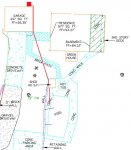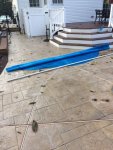I'm about to replumb my pool house (next to the pool) and was planning on adding an AquaCal SQ150 heat pump behind the pool house, but as I thought about it, it seemed to be quite loud where I'm trying to relax  My second thought is to move just the heat pump behind the garage. Besides not ever hearing the heat pump, the other benefit is that I actually have sufficient 150A panel in the garage to be able to power the heat pump, and don't need to run a new electrical conduit with expensive 8 AWG wires from behind the house to the pool. Instead, only a short run is necessary from the panel in the garage to the heat pump.
My second thought is to move just the heat pump behind the garage. Besides not ever hearing the heat pump, the other benefit is that I actually have sufficient 150A panel in the garage to be able to power the heat pump, and don't need to run a new electrical conduit with expensive 8 AWG wires from behind the house to the pool. Instead, only a short run is necessary from the panel in the garage to the heat pump.
However, there is a downside. The added distance AND the fact it will have about a 6' elevation off the pool where it enters the heat pump. The existing sand filter/heater piping is about 3' off the ground already (so really just adding 3' more elevation). I am switching to an IntelliFlo variable pump.
Now, I'm concerned about the distance. From the pool skimmer to the existing pool pad is 14 feet of 1.5" Schedule 40, and slightly smaller back to the return. From the existing pool pad the water would travel down Schedule 40 (buried underground, which should help with heat loss) from the pool pad about 48' to garage corner, than another 18' to the rear of the garage. So a total of approximately 80' overall distance (not including added distance within the pipes inside pool house) from the skimmer to the heat pump...and back.
Is this a bad idea? See attached photo for my plans. The red line is the full Schedule 40 pipe run to the red heat pump behind the garage.

Alternatively, if I install the heat pump right next to the pool house, I would need to excavate out about 3 feet behind it, for the platform for the heat pump and clearance, plus running about 80 feet of new 6AWG wiring from the electrical panel to the pool house to upgrade the wiring to handle 60+ amps. Plus possibly new underground conduit for a 20-foot section of that.
Thank you so much for any insights. Without TFP, I'd be lost with my pool.
However, there is a downside. The added distance AND the fact it will have about a 6' elevation off the pool where it enters the heat pump. The existing sand filter/heater piping is about 3' off the ground already (so really just adding 3' more elevation). I am switching to an IntelliFlo variable pump.
Now, I'm concerned about the distance. From the pool skimmer to the existing pool pad is 14 feet of 1.5" Schedule 40, and slightly smaller back to the return. From the existing pool pad the water would travel down Schedule 40 (buried underground, which should help with heat loss) from the pool pad about 48' to garage corner, than another 18' to the rear of the garage. So a total of approximately 80' overall distance (not including added distance within the pipes inside pool house) from the skimmer to the heat pump...and back.
Is this a bad idea? See attached photo for my plans. The red line is the full Schedule 40 pipe run to the red heat pump behind the garage.

Alternatively, if I install the heat pump right next to the pool house, I would need to excavate out about 3 feet behind it, for the platform for the heat pump and clearance, plus running about 80 feet of new 6AWG wiring from the electrical panel to the pool house to upgrade the wiring to handle 60+ amps. Plus possibly new underground conduit for a 20-foot section of that.
Thank you so much for any insights. Without TFP, I'd be lost with my pool.


